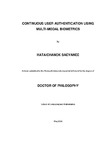Continuous User Authentication Using Multi-Modal Biometrics
| dc.contributor.supervisor | Clarke, Nathan | |
| dc.contributor.author | Saevanee, Hataichanok | |
| dc.contributor.other | School of Engineering, Computing and Mathematics | en_US |
| dc.date.accessioned | 2014-06-06T08:47:17Z | |
| dc.date.available | 2014-06-06T08:47:17Z | |
| dc.date.issued | 2014 | |
| dc.identifier | 10263960 | en_US |
| dc.identifier.uri | http://hdl.handle.net/10026.1/3033 | |
| dc.description.abstract |
It is commonly acknowledged that mobile devices now form an integral part of an individual’s everyday life. The modern mobile handheld devices are capable to provide a wide range of services and applications over multiple networks. With the increasing capability and accessibility, they introduce additional demands in term of security. This thesis explores the need for authentication on mobile devices and proposes a novel mechanism to improve the current techniques. The research begins with an intensive review of mobile technologies and the current security challenges that mobile devices experience to illustrate the imperative of authentication on mobile devices. The research then highlights the existing authentication mechanism and a wide range of weakness. To this end, biometric approaches are identified as an appropriate solution an opportunity for security to be maintained beyond point-of-entry. Indeed, by utilising behaviour biometric techniques, the authentication mechanism can be performed in a continuous and transparent fashion. This research investigated three behavioural biometric techniques based on SMS texting activities and messages, looking to apply these techniques as a multi-modal biometric authentication method for mobile devices. The results showed that linguistic profiling; keystroke dynamics and behaviour profiling can be used to discriminate users with overall Equal Error Rates (EER) 12.8%, 20.8% and 9.2% respectively. By using a combination of biometrics, the results showed clearly that the classification performance is better than using single biometric technique achieving EER 3.3%. Based on these findings, a novel architecture of multi-modal biometric authentication on mobile devices is proposed. The framework is able to provide a robust, continuous and transparent authentication in standalone and server-client modes regardless of mobile hardware configuration. The framework is able to continuously maintain the security status of the devices. With a high level of security status, users are permitted to access sensitive services and data. On the other hand, with the low level of security, users are required to re-authenticate before accessing sensitive service or data. | en_US |
| dc.language.iso | en | en_US |
| dc.publisher | Plymouth University | en_US |
| dc.subject | Biometrics | en_US |
| dc.subject | Authentication | en_US |
| dc.subject | Mobile Devices | en_US |
| dc.title | Continuous User Authentication Using Multi-Modal Biometrics | en_US |
| dc.type | Thesis | |
| plymouth.version | Full version | en_US |
| dc.identifier.doi | http://dx.doi.org/10.24382/3892 |
Files in this item
This item appears in the following Collection(s)
-
01 Research Theses Main Collection
Research Theses Main


